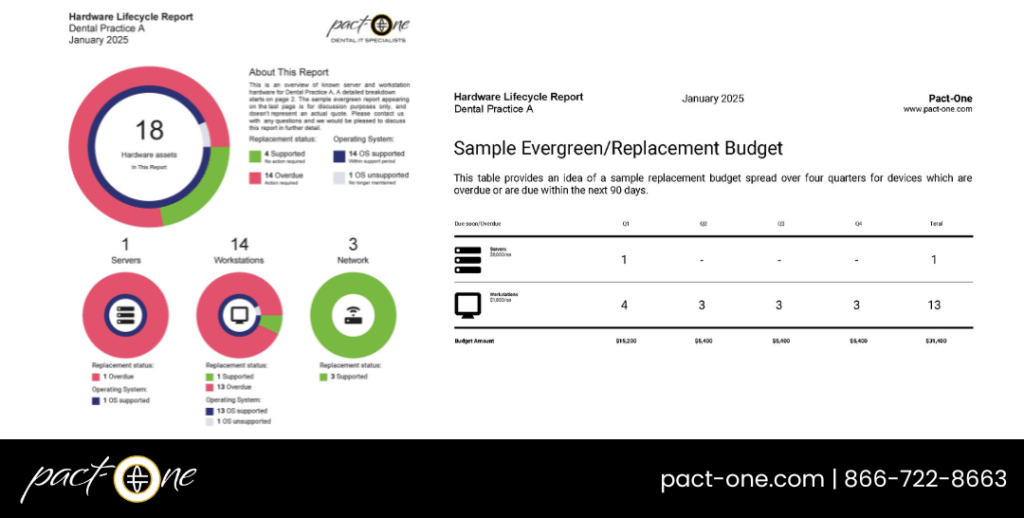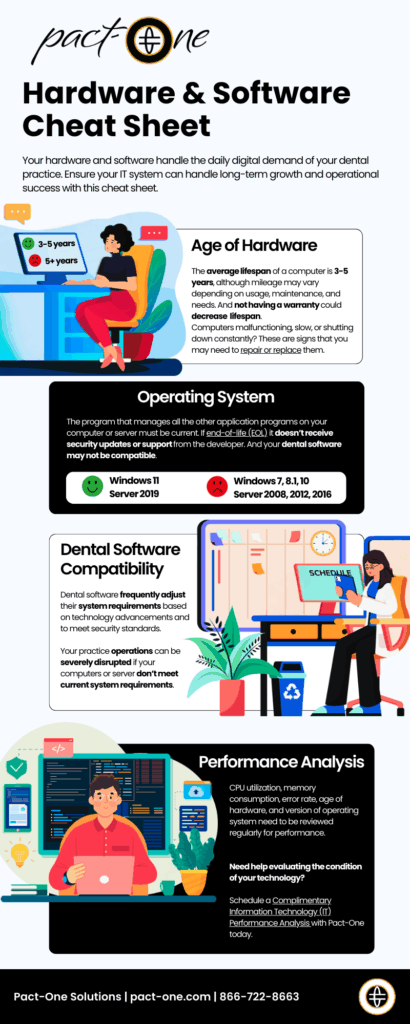You wouldn’t ask your hygienist to use a dull scaler or expect your front desk to use a rotary phone. So why would you rely on technology that belongs in a dental museum?
Here’s the truth: even if your old systems are technically still working, they’re likely slowing you down, introducing security vulnerabilities, and quietly draining your bottom line.
At Pact-One Solutions, we’ve helped thousands of dental practices uncover and address the hidden drag that outdated tech causes. This article will walk you through what outdated hardware really costs and how to fix it before it holds you back any further.
What Outdated Technology is Really Costing You
Let’s break down the three biggest consequences of outdated dental technology and how they show up in real practices like yours.
Lost Time = Lost Productivity
If your team is waiting for computers to boot up, software to load, or X-rays to process, you're not just wasting time...you're losing money. A few extra minutes here and there might seem harmless, but across a full day of patients? That lag adds up fast.
| Issue | Time |
|---|---|
| Jessica waits for a computer to boot up | 5 minutes |
| Sarah gets the spinning wheel of death every time she tries to access Dentrix | 20 minutes |
| Mindy is struggling with the intraoral camera capturing images in DEXIS | 30 minutes |
| Server decides to crash mid-day | 4 hours |
| TOTAL TIME | Approx. 5 hours |
Your front desk should be checking in patients quickly...not wrestling with a frozen screen. Your hygienists should be capturing images efficiently...not tapping the desk while the imaging software grinds.
Here's a real-world frustration we've seen firsthand:
“We are no longer able to send or receive x-rays via email in DEXIS format. Our IT company says it’s a setting in DEXIS that they can’t access. It was working fine until about 6–8 months ago. Every time we call for help we’ve been on hold over 30 minutes with no answer and had to hang up. This is very inconvenient and we’d like to have it resolved as quickly as possible.” — Dental Practice Inquiry, 2025
This is exactly the kind of productivity bottleneck that outdated hardware—and poor IT support—can cause. What used to take seconds now takes repeated phone calls, long hold times, and unresolved headaches. Meanwhile, patient care gets delayed and your team burns out trying to work around the issue.
Lost Revenue = Delayed or Missed Appointments
When a server crashes mid-day or your imaging system refuses to load, it doesn’t just disrupt workflow...it directly impacts your ability to treat patients. This can lead to canceled appointments, reschedules, or worse: a frustrated patient who decides to go to your competitor.
The cost of a missed or delayed appointment? Hundreds of dollars in lost production. Multiply that by a few hiccups per week, and you’re looking at thousands of dollars slipping through the cracks every month.
If you’re noticing consistent slowdowns or frequent crashes, you may be past due for a refresh. 7 Signs Your Dental Practice Has Outgrown Its IT can help you identify where the breakdown is happening.
Increased Risk = Compliance and Security Exposure
Old systems often mean outdated operating systems, which means no security updates. That’s like leaving the back door wide open and hoping no one notices. In today’s world of phishing attacks and ransomware, that’s a risk you just can’t afford.
Plus, if your system isn’t encrypted or backed up properly, you're violating HIPAA...even if it’s unintentional. And trust us, the fines aren’t kind.
HIPAA Red Flag: If your system hasn’t received a security update in the last 12 months—or you’re still running Windows 7 or 10—you're likely out of compliance and exposing your practice to avoidable risk.
Wondering what to do about the Windows 10 deadline? Start here: What Dental Practices Need to Know—and Do—Before Windows 10 Retires
Common Hardware Culprits in Dental Offices
Not all hardware ages equally. Some machines hang in there longer, while others need replacing sooner to keep up with dental software and security demands.
Here’s what to watch for:
| Hardware | Expected Lifespan | When to Replace |
|---|---|---|
| Computers (Workstations) | 3-5 years | Freezing, slow apps, can’t update software/operating system, out-of-warranty parts |
| Servers | 5-6 years | Downtime, noisy fan, backup issues, out-of-warranty parts |
| Firewalls | 3-5 years | Can’t block modern threats, lacks intrusion prevention |
| Network Switches | 5-7 years | Dropped connections, sluggish internet, phone call issues |
| Imaging/X-ray PCs | 4-6 years | Delays rendering images, inconsistent integration with imaging software |
Want help spotting the signs before something breaks? Check out Upgrading Your Dental IT Infrastructure: Is It Time? for a deeper dive into when to repair, when to replace—and how to plan your next move smartly.
Why Temporary Fixes Aren't the Answer
Sure, you might be able to “reboot it and hope for the best,” but that’s not a strategy. That’s a stall tactic.
Temporary fixes like system cleanups or “just deal with it” workarounds only mask the real problem: the tech is outdated and can’t keep up with the demands of dental workflows. And when something does fail (because it will), the fallout can be more costly than just replacing the hardware in the first place.
Think of it like dental equipment: you wouldn't keep using a handpiece that constantly stalls during preps, would you? Why do that with your IT tools?
Still unsure whether to repair or replace? This article breaks it down: Dental Office Computers: Repair vs. Replace
How to Upgrade Without Disrupting Patient Care or Taking a Hit to Your Budget
We get it...upgrades sound expensive, and downtime is your worst nightmare. But here’s the good news: when handled correctly, hardware upgrades can be seamless, strategic, and completely painless.
Here’s how Pact-One helps practices modernize without missing a beat:
- Assessment: We evaluate your entire setup (hardware, software, network) and flag what’s holding you back.
- Prioritization: You don’t have to replace everything at once. We help you identify what’s urgent and what can wait – providing you with various options through our Hardware Lifecycle Report (see below).
- Planning: We schedule upgrades during evenings, weekends, or your slowest production days.
- Execution: Our team handles procurement, logistics, installation, testing, and troubleshooting...so you don’t have to worry about a thing.
- Training: We make sure your team knows how to use the new hardware effectively from day one.

Example of a Hardware Lifecyle Report and Evergreen/Replacement Budget presented by Pact-One Solutions

Details of a Hardware Lifecyle Report presented by Pact-One Solutions
If you’re concerned about costs, we’ve got you covered—here are 5 Ways to Make Your Dental IT Project More Affordable
The Outcome: A Practice that Runs at Full Speed
Up-to-date hardware isn’t just a “nice to have”, it’s a competitive advantage. When your systems are fast, secure, and fully integrated...your entire team operates more efficiently. That means:
- Faster check-ins and smoother appointments
- More time for patient interaction
- Reduced IT stress and emergency calls
- Better integration with imaging and practice management software
- Improved HIPAA compliance and data security
- Higher patient satisfaction and team morale
Want to see how infrastructure impacts long-term growth? Read The Hidden Hero of Dental Expansion? Your IT Infrastructure
FAQs from Dentists and Office Managers
How do I know if my hardware is too old?
If your computers are more than 5 years old, freeze frequently, or can’t support the latest updates from your PMS or imaging software, they’re likely overdue for replacement.
Grab our Hardware & Software Cheat Sheet as a starting point.
How do I know which computers are best for my practice?
Great question...and one we get all the time. The “best” computers for your practice depend on how each workstation is used. For example:
- Front desk computers need to handle multitasking (scheduling, insurance, PMS access) quickly and securely.
- Operatory workstations need high-resolution graphics and compatibility with imaging and practice management software.
- X-ray/imaging stations require even more power...think fast processors, dedicated graphics cards, and solid-state drives.
Our team helps you choose the right specs based on software requirements and daily usage. We also take future growth into account so you don’t outgrow your equipment in 12 months.
For a breakdown of what we recommend in each category, check out The Ultimate Dental Technology Stack.
Can I upgrade a few things at a time?
Absolutely. We often recommend starting with your front desk, imaging systems, or any workstation that’s directly tied to patient care and compliance. Strategic, phased upgrades are budget-friendly and smart.
How long will an upgrade take?
- Workstation replacements: 2-3 hours (place computer; configuration; install practice management, imaging, and monitoring software; install endpoint and umbrella protection)
- Firewall installations: 30 minutes – 1 hour (configuration, test)
- Server replacements: 8 hours (migration of data, configuration, install software, install network security tools, configure backup device, join all computers, test, and cable management)
Should I buy or lease new hardware?
It depends on your cash flow and long-term goals. Leasing offers predictable monthly costs and simpler refresh cycles. Buying gives you full ownership and flexibility. We’ll walk you through both options.
What does a hardware assessment involve?
We take a close look at your systems, review performance, check for compliance gaps, and provide a custom roadmap for upgrades. No pressure, no tech speak...just clear, helpful advice.
Let's Make Sure Your Technology Works as Hard as You Do
If your dental technology is dragging you down, now’s the time to do something about it. Don’t wait for the next crash, compliance scare, or staff/patient complaint.
👉 Schedule a Dental Technology Assessment with Pact-One Solutions today. We’ll help you uncover where your systems are holding you back and build a plan to get you back on track.
Your patients deserve the best. So does your team. Let’s upgrade together.
Dental IT. Remove the Burden. Embrace the Use.
Quality patient care – it's ultimately why you became a dental professional. But, some business operations can get in the way (such as pesky computer issues or lack of IT support). That’s where Pact-One Solutions can help! Our passion lies in supplying reliable, responsive dental IT support and security that practices can count on.
Whether you’re looking for dental IT services for your startup or searching for more responsive dental IT support – our team of dental IT specialists have you covered. With team members throughout the United States, we offer nationwide support to dental practices of all sizes, specialties, and stages of growth. Our wide range of dental IT services ensure your data is secure, accessible, and protected.
Don't let technology challenges hinder your ability to deliver exceptional dental care. Contact us at info@pact-one.com or 866-722-8663 to join over 3,000 dental professionals thriving with the support of a dedicated dental IT team.




You must be logged in to post a comment.